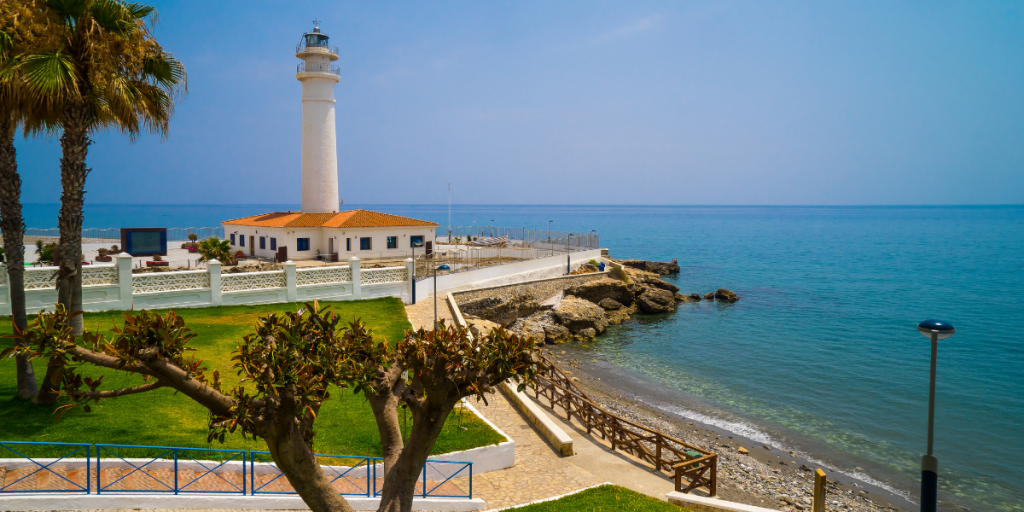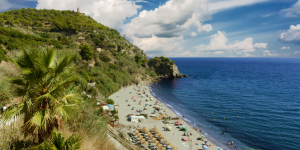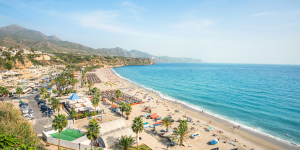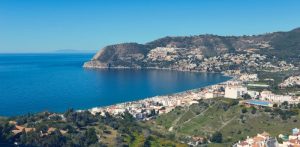It is the city with the best climate in Europe. You will only need to spend a few hours in this municipality of the Axarquia region, at any time of the year, to get to know its spectacular surroundings and find the answer to such a distinction.
With an average annual temperature of 18 degrees, Torrox lives in an eternal spring and has become the ideal example of the climate of the Costa del Sol. This privileged climate is due to the Torrox river valley which, being open to the sea, it makes the temperatures milder, while the surrounding mountains prevent the arrival of annoying winds.
With inland and coastal enclaves, separated by just four kilometers, Torrox has a subtropical landscape between mountains that mix with its seven beaches, some of which are distinguished each year with the Blue Flag. The most outstanding for their easy access and good services are the beaches of El Morche, Torcasol, Ferrara or El Peñoncillo.
Places to visit:
- Iglesia de Nuestra Señora de la Encarnación: The parish was built in 1505 by the archbishop of Seville, D. Diego Deza and confirmed in 1510 by the bishop, Diego Ramírez y Villaescusa de Haro.The original church had to be smaller, with only one nave and erected with Spanish bricks, masonry and wooden roof on the top. In 1630 it was renewed under the direction of one of the most important master builder of the time, D. Pedro Díaz de Palacios who was also in charge of the work renovation of San Juan Parish Church in Málaga. In the detailed valuation made by the workers in the 1630 report we obtain a very valuable information the Church. It was divided into there naves by six pillars and four half columns, from the end to the transept. After the improvements carried out during the 17th century the church was enlarged and redecorated with beautiful chapels around the lateral naves financed by the privileged persons of the village. Now all these marverllous artworks have disappeared during the 1936 Civil War: After the war it was redecorated in the forties in an neogothic style where a baptismal font that imitated a cave stood out. All the neogothic elements were eliminated during mid 1970s. At the moment is totally restored since 2014.
- Ermita de Nuestra Señora de las Nieves: it is located over a hill at the main entrance of the village and it became an important centre of piety in the region. It was an old Franciscan convent (Mínimos religious order). Its chapel has Latin cross plan and its central nave has square wooden frame roof and “lima bordón” work, that is typical Mudéjar style. In the main chapel a different wooden frame work called “armadura de tirantes de lazo” and with painting decorations. The wall of the main altar has “platerescos” decorative elements made in stucco work reproducing pilasters, capitals with a pediment over the top with a bust of the Painful Virgin in the tympanum. In 1646 the town Council applied for the piety foundation convent because it was traditional, at that time, this type of religious foundations in the main villages and also due to the work of a Mínimo monk from Torrox, Fray Juan Prado y Ugarte. In its origin it was authorised to work as a hospice, providing accommodation to the people who visit the village and it was at the beginning of the 18th century (1710) when it was consecrated as a convent by the San Francisco the Paula religious order in Genoa as “Convento torroxensis Madonna della Neve”. The confiscation of the properties of the church carried out by the minister Mendizábal in 1836 expropiated and transferred all the properties and now only the Chapel remains. The cloister was sold in public auctions and it was purchased by Fernado Sevilla, a wealthy merchant in 1854 and used it as raisin warehouse. At present is the central office of the social services and occasionally, for cultural activities and the chapel maintains its religious worship on Saturday evenings. It houses the images of San Roque and Ntra.Sra. de las Nieves, Patrons of Torrox. On the 5th August takes place a wonderful procession of the images to the main Church. There is a small garden area just by the chapel where we can find a mulberry tree, plants and flowers. There is a white Cross made out of stone (1.66m high). Its origin dated from the moment of the building of the convent. It was dismantled during the time of the República and reassemble again after this terrible period.
- Los Ingenios Azucareros: The sugar factories in all this area are normally called “ingenios”. The oldest was La Concepción, well-known such as “ingenio alto”, which was in use during the Moorish times and later on by the Christians. Under Christian rule, the town began to lose population, and in order to prevent greater abandonment queen Juana “la Loca” ordered Torrox to be repopulated with long-time Christians from the Basque Country, Valencia, Galicia and Málaga itself. The “Ingenio alto”, was rebuilt by Juan Triviño in the 17th century and it was working until mid 19th century when it felt into decline and was abandoned. During the Independence War, the French destroyed the fortress that used to stand where the Faro Lighthouse stands today, and also destroyed the port that had been adapted to handle coastal shipping. After that time there existed only in use the one known such as Ingenio Bajo or San Rafael. This is probably one of the most important one in the whole province because of the important owners it had such us: Francisco León Bendicho y Quilty, Cabarrús Count and the Larios family. On the 18th of august 1854 Francisco Javier de León Bendicho y Quilty, War Auditor and member of the Royal Academy of History sold the property which has been run by his family for more than 100 years. He even wrote a summary of the history of the property since the foundation period until the end under his own personal ownership. Under the control of this family the chimey tower was built as it is read in a large marble plate at its base. In the hands of the Larios family it operated until 1945, producing 22.000 quintales of sugar a year (1 quintal was equivalent to approximately 46kg. There were also a sugar factory in the coast called “San Javier”, it was created by Francisco de León Bendicho y Quilty, Manuel Agustín Heredia (iron-factory owner in Málaga) and Antonio de Escobar (landlord in Torrox) in 1815 but, unfortunately it never had a great success and it got bankrupt and without use before 1845.
- Torre Almenara de Huit : There exists information about this watchtower since 1497. It is approximately 3 kilometres far from the village in the direction to Torre del Mar. The Torre Vigía de Huit /Gui (Watchtower). It was built at the end of the fifteenth century and is known in Torrox as “torre de Güi” The structure is shaped as a truncated cone, virtually a cylinder, 25 m height and 23.4m base and is covered by a roof in the shape of a partial sphere. The openings in its masonry walls are extremely flared, as this design was better for defensive purposes. It is important to remark the link with Calaceite and Castillo Bajo watchtowers, these three granted the protection of Torrox town. These types of watchtowers were very popular in the whole Spanish territory during end of the 15th century until the 19th century. The period of building splendour was during Carlos I, Felipe II and Carlos III reigns. As for its artistic value, in this field the style is defined by two factors, its shape, almost always austere and the wise knowledge, exercise and mastery of the technical tradition and the materials, most of the time masonry, and sometimes reinforced in the corners with pieces of stone cut to square. Its origin dates back to the end of the XV century, these were reformed during the XVIII century and they were given the appearance that they have todayThe interior is usually divided into two floors, the upper one being the space for the home, with the fireplace and the cupboard. The presence of one or two windows allows lighting and ventilation. The roof usually has a parapet, and sometimes turrets equipped with loopholes, covered with Arabic tile.
- Torre Almenara de Calaceite: Torre Vigía de Calaceite (Watchtower) dates from the 15th century and it is located about 40 metres high, with a frustoconical shape in masonry and lime mortar, 9m. high and 22.30m basal circumference. The structure is shaped as a truncated cone, virtually a cylinder, and is covered by a roof in the shape of a partial sphere. The openings in its masonry walls are extremely flared, as this design was better for defensive purposes. These types of watchtowers were very popular in the whole Spanish territory during end of the 15th century until the 19th century. The period of building splendour was during Carlos I, Felipe II and Carlos III reigns. It is on the carretera nacional 340 in direction to Nerja. (vide Huit/ Gui watchtower)
- Casa de la Aduana: This building is known as The Customs house and it is from the 18th century. It has three floors and now is divided into three different houses. It is remarkable the upper side in the corner where we can appreciate iron pillars integrated. This building is a symbol of the richness of the village. The house underwent a great reform in the first half of the 19th century, adapting to the types and tastes of the splendor of the Elizabethan style of the time. Like almost all the houses in that part of Baja street, it has a large terrace overlooking the river and terraced gardens where a round wrought iron arbor is located. There are other two arbor in Torrox and they all must be inspired on the one we find now in Jardines de Picasso. This building is an emblematic piece of the municipality’s rich economic past. Baja street has been for many centuries the main axis of communication through royal roads and trails that were used by muleteers and merchants for the transit of goods. In this obligatory passage of products, Customs was established to collect the different commercial taxes and fees. During the 1920s balls and parties were celebrated by the upper middle class. When the original use of the building decayed it was sold and divided into three private houses. The government of the town tried to buy the whole building but only a third was possible and after a restoration period it had hold Antonio Medina´s Miniature collection. This singular museum had housed Antonio Medina´s collection of fairground attraction replicas in miniature. He has been working for more than five years on this curious project giving a melancholic vision of the old fairground attractions from the 1950s to the 1960s: La pista, la ola, las volaeras, el martillo, el churrero, and many others. These miniatures were displayed in three different rooms and the last one offered to the visitor a spectacular vision of the old town. A collection of posters from the Migas Festivity and old photos were also displayed to provide the visitor a general idea of the village during its Fair. Nowadays the building is closed due its tranformation into the Centro de Interpretación “Casa de la Aduana de Torrox”, which will hold the history of the village.
- Casa-Palacio de la Joya/ Hoya: Even though in the cast iron inner door we can read “José Sevilla 1864” the origin of this magnificent building is remote because that is the Sevilla´s family mansion, very important merchant people who exported wine,raisins, and different products form Málaga to America. They even had their own ship float. The splendour of this family is under the marriage between José Sevilla Gaona and Mª Dolores Medina (de la Coba) Mena. The origin of the family Medina de la Coba is one of the most important in this village and, without any doubt, one of the oldest origins which dates from the Catholic Queen and King (16th century). The economical influence of this family remains during the following centuries until the second half of the 20th century. The marriage between José Sevilla and Dolores Medina coincides with the maximum splendour of the house. The original structure of the house changed under this couple influence to its present construction. The house had more than 40 different rooms, an inner patio surrounded with cast iron Doric columns, some of them are in el Morche promenade now, the private chapel, the library and the garden, etc. The origins of this Garden can be traced back to the merging of several estates located at the back of the house. These were home to olive and almond trees and possibly vines, though the citrus trees were the most numerous. The gardens’ creators were José Sevilla Gaona and Dolores Medina Mena. Dolores inherited the land on which they stand in about 1864. They had originally come up with the idea of a garden during the works to improve the property and also inspired by the gardens in Málaga. For that reason they enlisted the services of a head gardener in charge of Málaga gardens, called José, who selected and planted the gardens’ flora, an endeavour carried out during the month holiday he had from his duties in the city. During this time in august he was lodged in one of the best rooms of the house in Torrox where he controlled all the instructions and works of the local gardeners. The garden was divided into two different parts: a French and a Mediterranean garden with a kitchen garden, a number of distinguished buildings were erected here: the magnificent Stately Home, the wineries, the administrator’s house, the gardener’s hut two iron greenhouses, fountains, footbridges, a large iron arbour with a path direct to the house called Jupiter´s way. In January 1885 His Majesty, Alfonso XII, visited Torrox in an official tour around Málaga as a result of the damages of the 1884 earthquake. The king is supposed to have slept in that house during his visit to the region. There was a replica of this mansion in the coastline area but it has been demolished. It was the popular Cortijo Sevilla in the Santa Rosa area at present. There was another summer residence in avenida del Faro, just opposite to the roman remains. At the beginning of the 1970s the property was purchased by the Diputación Provincial and the original garden has now disappeared. The house holds the local court of justice.
- Jardines de Picasso/ Polín: The origins of this Garden can be traced back to the merging of several estates located at the back of the house. These were home to olive and almond trees and possibly vines, though the citrus trees were the most numerous. The gardens’ creators were José Sevilla Gaona and Dolores Medina Mena. Dolores inherited the land on which they stand in about 1864. They had originally come up with the idea of a garden during the works to improve the property and also inspired by the gardens in Málaga. For that reason they enlisted the services of a head gardener in charge of Málaga Gardens, called José, who selected and planted the gardens’ flora, an endeavour carried out during the month holiday he had from his duties in the city. During this time in august he was lodged in one of the best rooms of the house in Torrox where he controlled all the instructions and works of the local gardeners. The garden was divided into two different parts a French and a Mediterranean garden with a kitchen garden, a number of distinguished buildings were erected here: the magnificent Stately Home, the wineries, the administrator’s house, the gardener’s hut two iron greenhouses, fountains, footbridges, a large iron arbour with a path direct to the house called Jupiter´s way.
- Ermita de San Roque: This chapel is placed in a small square, Plaza de San Roque, over an earlier church. The style is called neo mudéjar, very popular at the begging of the 20th century. It has only one nave and over the altar we find an incredible and marvellous vault which stays over four pechinas. The façade is made out of Spanish bricklaying and over the top we find a small horseshoe bell-gable, the same style of arch is found in the two windows over the main door.
- La Casa de la Inquisición: It is a three floors building with an indoor patiowhich was built in an early historical period (16th century). Although it has been modified with the passage of time its main façade and the iron and wooden work show us certain similarities with Nuestra Señora de las Nieves Chapel. Remarkable are the Spanish brick vaulted galleries of the basement. This house is supposed to be Alonso Algassy´s house and popular tradition ensures that it has housed certain offices of the Inquisition Tribunal. it seems that this house was owned by a wealthy Jew, a theory that would link to the court of the inquisition. In the 16th century Torrox had a numerous Jewish population. Moorish, Catholic, Jewish people lived together at that time. Among the Jewish population we find Luis de Torres “el lenguas”, Christopher Columbus´ interpreter on his first voyage to the New World. At present it is a private house and from calle baja we can admire the decorative elements in the façade, paintings (pending restoration), incised decorationand the magnificent iron work of its central balcony and windows.
- Iglesia de Santiago el Mayor: This Church has been built in 2007 over the old one which was a plain and small church built on the second half of the 20th century. In the church there is also the venerated Virgin of Carmen that goes out in procession in August during the celebration of the El Morche Fair.
- Villa el Recreo: Villa in belle epoch style, it was built at the end of the 19th century, private house with a magnificent garden. It has been preserved as it was designed until the end of 1990s, at this time some of the elements such as the waterwheel, the barn, the gardener house, the Andalusian patio were demolished to build new flat buildings and the 35 palm tree rows which flanked the main path entrance were affected by the red palm weevil and they had to be cut. At present remains the house built in a harmonious architectural ensemble showing the glorious past time. At the main door we find the water lilies fountain now empty.
- El Torreón: In the village we can find the so called “Moorish” tower, This building was acquired by the Town Hall in 1981, and restored in 1997 by international students from field work and the Town Hall. It follows the traditional characteristics of a Moorish watching towers, there used to be towers like this all along the wall of the town. It consists of two floors with vaulted ceilings called “tiro de cañón” made of brick in both floors. The roof is surrounded by battlements and in its south side a strategic loophole. After losing the use for which it was built, it was mainly used as a private home and even leaving the lower part for business. You can see old loopholes, now blind and the mix of different uses and types of bricks.
- El Hospital de San José: The origin of its foundation is very old, verified through different ancient documents that attest it and it was used to provide accommodation to the poor ones and to assist the sick people and the homeless of the time. There is no evidence of the family or institution which founded it. It has practically always been a ruin since its origin and its building was never completed. The most important part was the main entrance which has a niche with a San José sculpture. The old building was demolished due to its state of ruin and danger and at present it is a very peculiar apartment building because the façade was rebuilt reproducing he original entrance cover and a new niche has been built to set the sculpture in its original place.
- Chimenea Histórica: On the way to the old town just by to the high school “Jorge Guillén” we can find the old sugar factory, commonly known as “Ingenio de San Rafael”. The Chimney was built with a masterful use of the brick work over a stunning base where a marble plaque says: “it was made under the ownership of Francisco de León Bendicho, 1850”.
- Capillas callejeras y Oratorios: Special attention must be paid to the street chapels and oratories. They indicated the religiousness of the pubic space and they also have a practical use providing light to certain streets. The pieces we can find in Torrox correspond to votive niches on the façade of the houses and they were financed by the owners of these houses. These architectural elements were very popular during the 18th century. At this time Torrox obtained a prosperous economical relevance and these chapels were the result of pious foundations to perpetuate the power of these families.
- Arcos y Fuentes: We can find some constructions to conduit the water from one side of the street to the other, creating arches. These are old system of water transportation and there are some on the way to the old sugar factory called “la Concepción” known as “Ingenio Alto” which dates from the 16th century. We find these old elements in Callejón de Santa Teresa de Ávila. At this point we can also find a water fountain from the 1960s, some more can be found in calle Paz, calle Pontil and the one in Calle Almedina. There were some older fountains made of marble and with rich and baroque decorative elements but they are all disappeared.
- Balcón Mirador del Mediterráneo: Placed over the factory-necropolis Roman remains we find the “Balcón Mirador del Faro”, made of iron and with a glass floor. From that point we can be amazed by the magnificent view of the Mediterranean Sea and by the Roman remains under our feet. It is located at the end of the Avenida del Faro
- Cañón del Castillo: It is one of the cannons from the Castle. It is not known if it belongs to the one in Torrox pueblo (Castillo Alto) or the one in the coast area (Castillo Bajo). It is located on the narrow promenade on the way to the factory/ necrópolis in the Faro settlement.
- El Faro: This lighthouse is located in the south coast of Torrox. Its building finished on the 1st may 1864. It is automatic. Its height is 39 metres over the sea and 26 metres at floor level. The lighthouse was built over an old fortress called “Castillo Bajo” which was destroyed by the Napoleonic invasion in the beginning of the 19th century. The lighthouse is surrounded by roman remains: the villa, where we can admire the roman mosaics.
- El Portón: It is a natural gateway located between calle baja and calle alta. This gateway is the entrance to a street labyrinth with a strong mudéjar influence. In the 1990 was covered with Spanish bricks and it is part of the Almanzor´s Route. It is located in Puerta del Sol.
- Escultura El Toque de la Carcola: This sculpture has been made by Francisco Martín. This sculpture celebrates the 25 years anniversary of the “Día de las Migas” which is celebrated on the Sunday before Christmas Day. The sculpture represents a worker in the country playing a sound with the seashell to get together with the rest of the country workers to have lunch.
- Escultura el tiro de la traya: This sculpture has been made by Francisco Martín. This sculpture represents a fisherman working as it was typical in this area. The sculpture shows the hardness of these works carried out by the most humble people of the society.
- Conjunto La Granja: In this area we find the swimming-pool, the sport centre and the football stadium of the village. At the beginning of the 19th century there was a Centro de Experimentación Agrícola (reseach center to investigate about the phylloxera and subtropical plants in the area). The old aqueduct which provided the water supplies and some of the old trees are the remaining examples of the previous center.
- Plaza de la Constitución: Even though the plaza is not a physical monument itself, la Plaza, it the meeting point in the village everything happens. The plaza has been renewed in several times and now shows a new one which has caused much controversy about it. The plaza is the space where all the important moments of the people life take place: baptism ceremonies, weddings, funerals, demonstrations, processions, parades, concerts, Ferias, etc… It is the meeting point par excellence, to have a good time in good company in one of the terraces where you can enjoy our wide variety of tapas or simply have a wonderful dinner in that beautiful area. It is the place where all our tourist routes meet.
- Termas: “Termas” or Public Baths were buildings which possessed all the necessities for the care of the body (changing rooms, baths with cold, tepid and hot water) for men and women. The baths at Torrox have suffered serious deterioration, but is still possible to make a study of them. They are not excessively large, being similar in style to private baths. The building has a rectangular design, to which a series of rooms has been added on its southern and eastern sides. The room plan is: The praefurnia, where the furnance and the coppers were installed and the caldarium with the hot water. These heated the hypocaust (space under the floor through which the hot air circulated), the tepidarium with tepid water and the frigidarium with the cold ones. All of them covered with marble and mosaics. In the surroundings, it has also appeared remains of a private house, pavement of the old calzada (road) and water drainage, dating from the third century A.D.
- La Villa Romana: The archeological site of Torrox Lighthouse, since it was first excavated at the beginning of the 19th century, has offered material evidence confirming its importance as an agricultural and fishing centre, with a thriving export trade. The extent of the “villa”, the fishing activities, the relatively proximity to the African coast (where there are numerous unexcavated Spanish settlements), the commercial value of the salting industry, all this demonstrate that the zone had many contacts with other parts of the Mediterranean. Some think the site could have been connected to a more important one, Caviclum, which was situated on the “Itinerario Antonino” (“Antoninus´Way) which ran between Mainoba (at the mouth of the river Vélez) and Sexi (present day Almuñécar). Unfortunately the urbanization built in the surroundings of the lighthouse had made to disappear others important elements of the whole town. That is why the remaining ones are an interesting testimony of our past. The villa was first found and excavated in 1905 during some improvements made on the garden by TomásGarcía (worker in the lighthouse). Several rooms around a little atrium appeared and they all were again excavated in the 1940s by Simeón Giménez Reyna. This is inside the lighthouse precinct, where some of the room-walls are still standing and this was possibly an area of private houses. These were well decorated, although the materials employed in the construction were not lavish: However the ornamentation helped to give a more luxurious appearance. All the rooms had mosaics, some of which are now preserved in the Archeological Museum in Málaga and Barcelona. There are still some tessealas (small pieces of mosaic) in situ and in some corners one can see fragments of plastered wall with a decorative red line. All the rooms are placed around the atrium, a type of courtyard with a small trough or bowl in the centre for collecting rainwater. The villa dates from around the third century A. D. A special interest must be paid to the mosaics found in Torrox and preserved in the Archeological Museum in Málaga because of its unusual motives and conservation which make them rare and significant masterpieces of this period. In this part of the complex, within the former lighthouse keeper’s, is now the Interpretation Center of the Roman Ruins of the Torrox Lighthouse, which houses an interesting exhibition itinerary that helps us to understand how this settlement was in Roman times.





